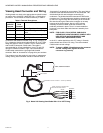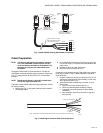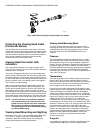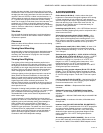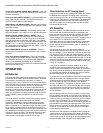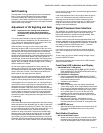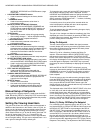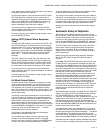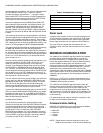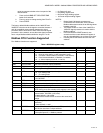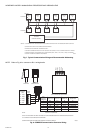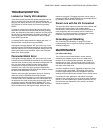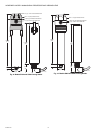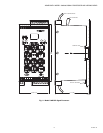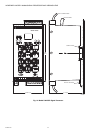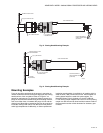
HONEYWELL MODEL 700/800 SIGNAL PROCESSOR AND VIEWING HEAD
66-2069—02 14
the computed ratio, for example, “AC” and “75.” Press either the
ACCEPT RATIO or RESET keys. If ACCEPT RATIO is
pressed, the display responds with “- -”, the ratio is stored,
and the AUTO SET LED is turned on. If RESET is pressed, the
display returns to the counts, both of the AUTO SETUP LEDs
are turned off, and the old setpoints are used.
If the ratio computed as a result of BNR-ON and BNR- OFF
data sampling is higher than 80%, the display will show “UA”
(unacceptable), alternating with the unacceptable ratio. For
example, if the computed ratio is 93%, the display would
alternate between “UA” and “93.” RESET must be pressed to
clear this; the old values for RELAY ON and RATIO will remain
in effect.
The values can be worse than just unacceptable. If the flame
relay de-energizes while reading BNR-ON values, the display
will show “bo,” and data-taking will be aborted. Other faults,
such as a BNR-ON flame signal that is too low to use, or BNR-
OFF readings that are too close to the BNR-ON readings, can
result in “rE” being displayed. RESET should then be pressed.
The signal processor also adjusts the viewing head gain during
the BNR-ON and BNR-OFF data sampling sequence.
Normally, after the sequence, the display should read about
20, because the gain has been adjusted to give this reading. If
it is less than about 18, you should find that the gain has been
set to 9; if it is more than about 22, you should find that the
gain has been set to 1.
Once the values have been stored through this sequence, you
can check the RELAY ON SET POINT, the RATIO, or the
GAIN by pressing the appropriate key for two seconds.
However, if you attempt to change these values by pressing
the INCREASE or DECREASE keys, the display will show
“CF” (confirm), and the AUTO SET LED will flash rapidly. To
confirm the desired change, press the RELAY ON SET-POINT
key, the RATIO key, or the SET GAIN key a second time. To
discontinue any changes, press the RESET key or simply wait
four seconds for a time out to occur.
The user confirms they wish to make changes, the values will
change when you use the INCREASE or DECREASE keys.
Meanwhile, the AUTO SET LED will be flashing. The AUTO
SET LED will de-energize only if the changed values are
stored; if the changed values were not stored, the AUTO SET
LED will light and the old values will remain in effect.
If values were obtained automatically, that is, if the AUTO SET
LED is on and the BNR-ON SEQ START/END key is pressed,
the display will also show “CF.” If the BNR-ON SEQ START/
END key is pressed again, the signal processor will begin the
BNR-ON data sampling sequence.
Loading Factory Defaults
Fig. 18 shows the flowchart for restoring default values.
Pressing and holding the LOAD FACTORY DEFAULTS button
will result in the values shown in Table 3 being loaded and
stored in EEPROM. During the automatic setup sequence, if
the AUTO SET LED is on when the LOAD FACTORY
DEFAULTS key is pressed, “CF” will be displayed. Press the
LOAD FACTORY DEFAULTS key again to confirm the change,
or press RESET to abort the change. If the factory defaults
are loaded, the AUTO SET LED will be turned off.
Panel Lock
A pattern of key presses will result in the panel being locked
so as to block any changes to the values stored in the signal
processor. With the panel locked, values may be examined,
but the signal processor will not respond to the STORE key.
The panel should be locked after the setpoints are set.
Contact the factory to obtain the procedure to lock or unlock
the panel.
MODBUS COMMUNICATION
The 700ACSP and 700DCSP signal processors are capable
of communication with Flametools software running on a
Microsoft
®
Windows
®
PC, S7999D touch screen or other
device that supports Modbus RTU protocol. Both Flametools
and the S7999D include graphic user interfaces. Other
devices will require the user to generate an interface. The data
transmitted to and from the 700ACSP/700DCSP is over two
twisted pairs that are differentially driven and received
according to the RS-422 standard. Honeywell offers a RS485/
422 to USB converter to use in conjunction with the 700ACSP/
700DCSP signal processors. The Honeywell part number is
COMMOD.
Refer to Fig. 7 and Fig. 8 for a typical communication wiring
and addressing scheme as well as the required wiring of the
COMMOD communication converter.
The 700ACSP and 700DCSP signal processors have two
modular phone jacks for RS-422 communications. The jacks
are wired in parallel so that point-to-point cables can be
jumped from unit to unit to interconnect multiple Model 700
signal processors. The RS-422 interface IC is a MAX489. The
ICs can drive up to quantity 32, Model 700 signal processors
on the same bus.
For communication with external controls or computers, refer
to Table 4 for the Modbus registers map.
Communication Setting
700ACSP and 700DCSP can only communicate via Modbus
RTU protocol, with the following configuration:
• 9600 baud
• 8 data bits
•no parity
• 1 stop bit
NOTE: Default protocol must be changed in order to use
Modbus communication. It may be set for Modbus by
Table 3. S70X/S80X Default Settings
Relay on setpoint 16
Ratio (%) relay off/relay on 50%
FFRT (Flame Fail Response Time) 1 sec
0-20mA/4-20mA OPTION 4-20mA
UV/IR Gain 5
Communication address 0



